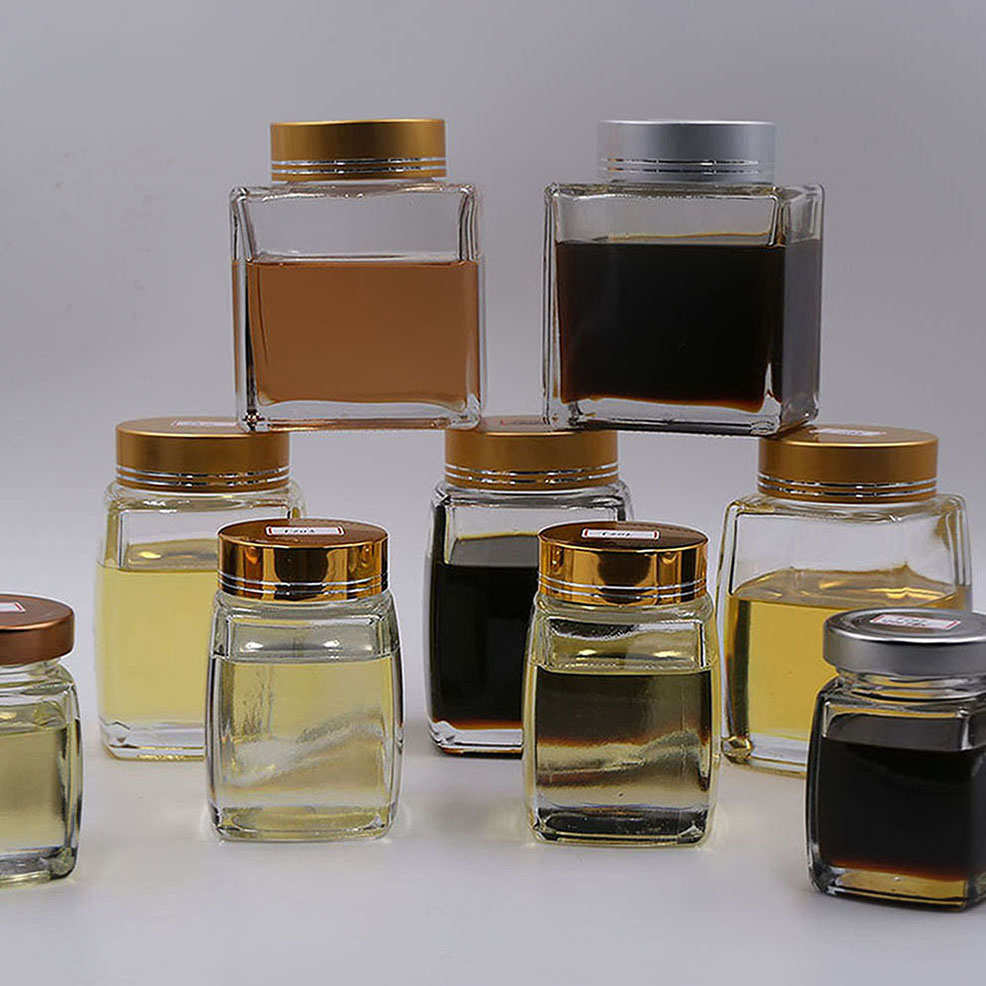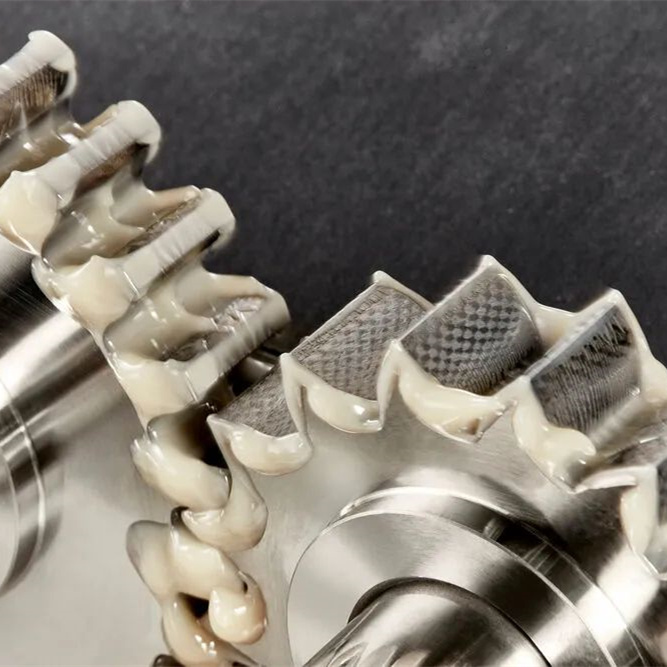In summary, Zinc Dialkyl Dithiophosphate (ZDDP) corrosion inhibitor is a versatile and effective additive that offers exceptional anti-wear, antioxidant, corrosion protection, load-carrying capacity, and thermal stability properties. Its unique composition and characteristics make it a vital component in lubricant formulations for various automotive, industrial, and marine applications.
2. Reaction mechanism of the product The reaction mechanism of Zinc Dialkyl Dithiophosphate (ZDDP) corrosion inhibitor involves several complex processes that contribute to its excellent anti-wear and antioxidant properties. Let's delve into the detailed reaction mechanism of this important additive:
Formation of Protective Films:
When ZDDP is added to a lubricant, it undergoes reactions with metal surfaces to form protective films. The zinc cation (Zn^2+) in ZDDP reacts with metal oxide surfaces, such as iron oxide (Fe2O3), to form zinc oxide (ZnO) films. These films act as barriers, preventing direct metal-to-metal contact and reducing frictional wear.
Adsorption and Tribochemical Reactions:
ZDDP molecules adsorb on metal surfaces due to their polar nature. The alkyl groups in ZDDP interact with surface-active metals, such as iron (Fe), copper (Cu), and lead (Pb), forming strong chemical bonds. This adsorption process enhances the effectiveness of the inhibitor by providing a stable and protective surface layer.
Under high-pressure and high-temperature conditions, ZDDP undergoes tribochemical reactions. The phosphate groups in ZDDP react with metal surfaces to form iron phosphate (FePO4) and zinc phosphate (Zn3(PO4)2) compounds. These compounds have low solubility and act as solid lubricants, reducing friction and minimizing wear.
Acid-Base Reactions:
ZDDP can also undergo acid-base reactions in the presence of moisture. The dithiophosphate anion in ZDDP reacts with acidic corrosion products, such as sulfuric acid (H2SO4), generated during the combustion process. This neutralizes the acid and prevents further corrosion, protecting the metal surfaces from degradation.
Radical Scavenging:
ZDDP exhibits excellent antioxidant properties due to its ability to scavenge free radicals. The phosphorus moiety in ZDDP acts as a radical scavenger, intercepting and neutralizing reactive species generated during lubricant oxidation. This reduces the formation of corrosive by-products and helps maintain the oxidative stability of the lubricant.
Passivation of Metal Surfaces:
One of the important functions of ZDDP is the passivation of metal surfaces. The zinc oxide (ZnO) and zinc phosphate (Zn3(PO4)2) films formed during the reactions act as stable passivation layers, inhibiting the corrosion of metal surfaces. These films prevent the exposure of the underlying metal to corrosive environments, such as moisture or acidic compounds.
Synergistic Effects:
ZDDP can also interact synergistically with other additives commonly present in lubricant formulations, such as detergents and dispersants. These interactions further enhance the anti-wear and antioxidation properties of ZDDP, improving the overall performance of the lubricant.
In conclusion, the reaction mechanism of Zinc Dialkyl Dithiophosphate (ZDDP) corrosion inhibitor involves the formation of protective films, adsorption and tribochemical reactions, acid-base reactions, radical scavenging, passivation of metal surfaces, and synergistic effects. These mechanisms contribute to its exceptional anti-wear, antioxidant, and corrosion inhibition properties, making ZDDP an essential component in lubricants for various applications.
3. Use of the product Zinc Dialkyl Dithiophosphate (ZDDP) corrosion inhibitor is a versatile additive that finds wide-ranging applications in various industries due to its exceptional anti-wear, antioxidant, and corrosion protection properties. Let's explore the diverse applications of this important additive:
Automotive Industry:
ZDDP is extensively used in automotive lubricants, including engine oils, transmission fluids, and gear oils. In engine oils, ZDDP helps to reduce friction and wear on engine components such as camshafts, pistons, and bearings. It also provides excellent protection against corrosion, especially in engines operating under high temperatures and pressures. Additionally, ZDDP enhances the load-carrying capacity of lubricants, making it crucial for high-performance engines.
Industrial Machinery:
In industrial applications, ZDDP is utilized in hydraulic fluids, compressor oils, and industrial gear oils. The anti-wear properties of ZDDP are particularly beneficial in heavy-duty machinery where components are subjected to extreme pressure and sliding contact. The corrosion protection offered by ZDDP helps to prolong the service life of machinery by preventing rust and corrosion in critical parts.
Marine Applications:
ZDDP is commonly incorporated into marine lubricants for use in ship engines, gears, and hydraulic systems. The additive's ability to form protective films on metal surfaces helps to safeguard marine equipment against wear and corrosion, even in harsh marine environments. ZDDP plays a vital role in ensuring the reliable operation of marine machinery and extending maintenance intervals.
Aerospace Sector:
In the aerospace industry, ZDDP is utilized in aviation lubricants for aircraft engines, landing gear systems, and hydraulic systems. The anti-wear and antioxidant properties of ZDDP are crucial for maintaining the performance and safety of aircraft components under demanding operating conditions. The corrosion protection provided by ZDDP helps to mitigate the effects of moisture and environmental factors on critical aircraft parts.
Metalworking Fluids:
ZDDP is added to metalworking fluids such as cutting oils and coolants to improve tool life and surface finish during machining processes. The anti-wear characteristics of ZDDP help to reduce tool wear and extend cutting tool longevity, enhancing machining efficiency. The antioxidant properties of ZDDP also contribute to the stability of metalworking fluids by inhibiting oxidation and degradation.
Power Generation:
ZDDP is used in lubricants for power generation equipment such as turbines, generators, and compressors. The additive's ability to reduce friction and wear on moving parts helps to optimize the performance and efficiency of power generation systems. ZDDP also provides essential protection against corrosion, ensuring the reliability and longevity of critical power generation components.
In conclusion, Zinc Dialkyl Dithiophosphate (ZDDP) corrosion inhibitor is a versatile additive with widespread applications across industries such as automotive, industrial machinery, marine, aerospace, metalworking, and power generation. Its unique combination of anti-wear, antioxidant, and corrosion protection properties makes it indispensable for enhancing the performance, longevity, and reliability of various mechanical systems and equipment. 4. Production application examples in China China is a significant player in the production and application of Zinc Dialkyl Dithiophosphate (ZDDP) corrosion inhibitor, with a growing presence in various industries. Let's explore some examples of how ZDDP is produced and applied in China:
Production Facilities: China boasts several state-of-the-art production facilities that manufacture ZDDP corrosion inhibitors using advanced technologies and processes. These facilities adhere to strict quality control measures to ensure the production of high-quality additives that meet international standards.
Automotive Lubricants: ZDDP produced in China is widely used in the formulation of automotive lubricants, including engine oils, transmission fluids, and gear oils. Chinese automotive manufacturers and lubricant producers rely on ZDDP to enhance the performance and longevity of vehicle engines by providing exceptional anti-wear and antioxidant properties.
Industrial Machinery: Chinese industries utilize ZDDP in hydraulic fluids, compressor oils, and industrial gear oils to protect machinery components from wear and corrosion. ZDDP's ability to form protective films on metal surfaces is particularly beneficial in heavy-duty machinery applications, where components are subjected to high pressures and temperatures.
Marine Sector: In China's maritime industry, ZDDP is incorporated into marine lubricants to safeguard ship engines, gears, and hydraulic systems from wear and corrosion. The use of ZDDP helps ensure the reliability and efficiency of marine equipment, enabling vessels to operate smoothly even in challenging marine environments.
Aerospace Applications: Chinese aviation companies utilize ZDDP in lubricants for aircraft engines, landing gear systems, and hydraulic systems. ZDDP's anti-wear and antioxidant properties play a crucial role in maintaining the performance and safety of aircraft components, ensuring smooth operations and reducing maintenance requirements.
Metalworking and Manufacturing: Chinese metalworking and manufacturing sectors utilize ZDDP in cutting oils and coolants to enhance tool life and surface finish during machining processes. By reducing tool wear and improving machining efficiency, ZDDP helps increase productivity and quality in metalworking operations.
Power Generation: ZDDP produced in China is also used in lubricants for power generation equipment such as turbines, generators, and compressors. The additive's ability to reduce friction and wear on critical components helps optimize the performance and longevity of power generation systems, contributing to reliable and efficient energy production.
In conclusion, China's production and application of Zinc Dialkyl Dithiophosphate (ZDDP) corrosion inhibitor span a wide range of industries, including automotive, industrial machinery, marine, aerospace, metalworking, and power generation. The country's advanced production capabilities and widespread adoption of ZDDP additives underscore its importance in enhancing the performance, durability, and reliability of various mechanical systems and equipment in the Chinese market.5. Packaging and storage Packaging and storage of Zinc Dialkyl Dithiophosphate (ZDDP) corrosion inhibitor are crucial aspects to ensure the quality, effectiveness, and safety of the product. Proper packaging and storage conditions help maintain the stability and performance of the inhibitor throughout its shelf life. Let's delve into the details of how ZDDP corrosion inhibitor is packaged and stored:
Packaging Materials: ZDDP corrosion inhibitor is typically packaged in containers made of materials that are compatible with the chemical properties of the additive. Common packaging materials include plastic drums, metal drums, and intermediate bulk containers (IBCs). These containers are designed to protect the inhibitor from external contaminants and prevent leakage during handling and transportation.
Sealing Mechanisms: The packaging of ZDDP corrosion inhibitor is equipped with reliable sealing mechanisms such as screw caps, bungs, or closures to ensure airtight and leak-proof seals. Proper sealing helps prevent the ingress of moisture, air, or other contaminants that could compromise the quality of the inhibitor.
Labeling and Identification: Each package of ZDDP corrosion inhibitor is labeled with important information such as product name, manufacturer details, chemical composition, safety precautions, and handling instructions. Clear and accurate labeling is essential for proper identification, handling, and usage of the inhibitor.
Storage Conditions: ZDDP corrosion inhibitor should be stored in a cool, dry, and well-ventilated area away from direct sunlight, heat sources, and incompatible materials. The storage temperature should be within the recommended range specified by the manufacturer to prevent degradation of the inhibitor. Extreme temperatures should be avoided to maintain the stability of the product.
Avoiding Contamination: It is important to store ZDDP corrosion inhibitor away from sources of contamination such as acids, alkalis, oxidizing agents, and strong mineral acids. Contamination can affect the performance and efficacy of the inhibitor, leading to potential safety hazards during use.
Handling Precautions: When handling ZDDP corrosion inhibitor, proper personal protective equipment (PPE) should be worn, including gloves, safety goggles, and protective clothing. Spills should be cleaned up immediately using appropriate absorbent materials. Care should be taken to avoid skin contact, inhalation, or ingestion of the inhibitor.
Shelf Life and Expiry Date: ZDDP corrosion inhibitor has a limited shelf life, and it is important to adhere to the recommended storage conditions and expiry date specified by the manufacturer. Using expired or degraded inhibitor can lead to reduced effectiveness and performance.
Transportation Guidelines: During transportation, ZDDP corrosion inhibitor should be securely packaged and labeled in accordance with regulatory requirements. It should be transported in a manner that prevents damage, leakage, or contamination, ensuring the safety of handlers and the environment.
In conclusion, proper packaging and storage of Zinc Dialkyl Dithiophosphate (ZDDP) corrosion inhibitor are essential to maintain its quality, effectiveness, and safety. By following the recommended guidelines for packaging, sealing, labeling, storage, handling, and transportation, users can ensure the integrity of the inhibitor and optimize its performance in various applications.6. Product production process The production process of Zinc Dialkyl Dithiophosphate (ZDDP) corrosion inhibitor involves several key steps that ensure the quality, purity, and effectiveness of the final product. Let's explore the detailed manufacturing process of ZDDP corrosion inhibitor:
Raw Material Preparation: The production begins with the procurement of high-quality raw materials including zinc oxide, dialkylphosphorodithioic acid, and alcohol. These raw materials must meet stringent quality standards to ensure the desired chemical composition and properties of the inhibitor.
Chemical Reaction: The first step in the manufacturing process involves the chemical reaction between zinc oxide and dialkylphosphorodithioic acid in the presence of alcohol. This reaction results in the formation of the primary component of ZDDP, which is crucial for its corrosion inhibiting properties.
Addition of Additives: Additional additives such as antioxidants, dispersants, and anti-wear agents may be incorporated into the formulation to enhance the performance and stability of the ZDDP corrosion inhibitor. These additives help improve the inhibitor's effectiveness in protecting metal surfaces from corrosion and wear.
Mixing and Homogenization: The components are mixed and homogenized in specialized equipment to ensure uniform distribution of the ingredients and to achieve the desired consistency and viscosity of the final product. Proper mixing is essential to maintain the quality and efficacy of the inhibitor.
Filtration and Purification: The mixture undergoes filtration processes to remove any impurities or solid particles that may affect the quality of the ZDDP corrosion inhibitor. Purification steps are carried out to ensure the inhibitor meets the required purity standards.
Quality Control Testing: Throughout the production process, samples of the ZDDP corrosion inhibitor are taken for quality control testing. These tests assess the inhibitor's chemical composition, purity, stability, and performance characteristics to verify that it meets the specified requirements.
Packaging and Storage: Once the production process is complete and the ZDDP corrosion inhibitor has passed quality control testing, it is packaged into suitable containers such as drums, totes, or tanks. Proper labeling and identification are applied to the packaging to provide essential information to users. The packaged inhibitors are then stored in controlled environments to maintain their quality and shelf life.
Regulatory Compliance: The production of ZDDP corrosion inhibitor must comply with regulatory standards and safety guidelines to ensure the safety of workers, the environment, and end-users. The manufacturing facility must adhere to relevant regulations governing the production, handling, and storage of chemical substances.
In conclusion, the production process of Zinc Dialkyl Dithiophosphate (ZDDP) corrosion inhibitor involves a series of precise steps including raw material preparation, chemical reaction, additives incorporation, mixing, filtration, quality control testing, packaging, and regulatory compliance. By following these rigorous processes, manufacturers can produce high-quality ZDDP corrosion inhibitors that effectively protect metal surfaces from corrosion and wear in various industrial applications.7.Product precautions Zinc Dialkyl Dithiophosphate Corrosion Inhibitor: Product Precautions
Zinc Dialkyl Dithiophosphate (ZDDP) corrosion inhibitor is a crucial component in various industries to protect metal surfaces from corrosion and wear. While ZDDP is highly effective in its corrosion-inhibiting properties, it is essential to follow certain precautions to ensure the safe handling, storage, and usage of this product. Here are some key product precautions to be taken into consideration:
Personal Protective Equipment (PPE): When handling ZDDP corrosion inhibitor, it is imperative to wear appropriate personal protective equipment such as gloves, safety goggles, and protective clothing to prevent skin contact, eye irritation, and inhalation of fumes.
Ventilation: Ensure adequate ventilation in the working area to minimize exposure to ZDDP vapors. If working in enclosed spaces, use proper ventilation systems or wear respiratory protective equipment to avoid inhalation of potentially harmful fumes.
Storage: Store ZDDP corrosion inhibitor in a cool, dry, and well-ventilated area away from direct sunlight and sources of ignition. Keep the product in its original sealed containers and away from incompatible materials to prevent contamination or reaction.
Handling: Avoid direct contact with skin or eyes when handling ZDDP corrosion inhibitor. In case of accidental contact, immediately wash the affected area with water and seek medical attention if irritation persists. Do not ingest the product and always wash hands thoroughly after handling.
Spill Response: In the event of a spill, contain the area to prevent further contamination and contact with individuals. Use absorbent materials to clean up the spill and dispose of them in accordance with local regulations for hazardous waste management.
Fire Precautions: ZDDP corrosion inhibitor is combustible and may release toxic fumes when exposed to high temperatures. Keep the product away from open flames, sparks, or heat sources. In case of a fire involving ZDDP, use appropriate firefighting measures and equipment.
Compatibility: Ensure that ZDDP corrosion inhibitor is compatible with the materials and surfaces it will come into contact with. Check for any potential reactions with other chemicals or metals to avoid adverse effects on the application or equipment.
Regulatory Compliance: Adhere to all relevant regulations, guidelines, and safety protocols when using ZDDP corrosion inhibitor. Ensure that the product is handled and disposed of in accordance with local, state, and federal regulations to prevent environmental harm.
Training: Provide proper training to personnel involved in the handling, storage, and application of ZDDP corrosion inhibitor. Educate them on the potential hazards associated with the product and the necessary precautions to be taken to ensure safety.
By following these product precautions, users can effectively mitigate risks associated with the handling and usage of Zinc Dialkyl Dithiophosphate corrosion inhibitor, ensuring a safe working environment and optimal performance of the product in corrosion protection applications.
We are focusing on various
Lubricant Additive Component &
Additive Package, as well as
Metal Working Fluid, component include
Pour Point Depressant,
Viscosity Index Improver, Antiwear/
Ep Additive, Antioxidant, Rust Preventative, Detergent,
Ashless Dispersant, etc.,









